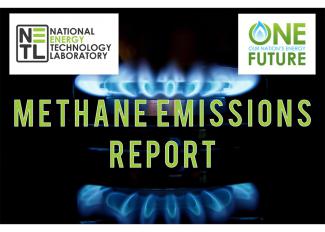NETL recently collaborated with Our Nation’s Energy (ONE) Future, a coalition of 26 natural gas companies, to calculate the greenhouse gas (GHG) emission profile and methane emission rates across the group’s complete natural gas value chain.
The report, Industry Partnerships & Their Role In Reducing Natural Gas Supply Chain Greenhouse Gas Emissions – Phase 2, leveraged NETL’s world-class life cycle analysis (LCA) tools to directly compare this data to the emissions profile and emissions rates of the entire U.S. natural gas sector and recommended several methane emission reduction strategies specific to various geographic regions within ONE Future’s natural gas supply chain.
ONE Future comprises some of the largest natural gas production, gathering and boosting, processing, transmission and storage, and distribution companies in the nation and represents approximately 15% of the U.S. natural gas value chain.
The report compares ONE Future’s supply chain with the U.S. supply chain using a functional unit of 1 megajoule of delivered natural gas as well as a few end-use scenarios, including gas powerplants and gas exports in the form of liquefied natural gas.
“To improve comparability, this analysis used NETL's life cycle natural gas model and populated it with ONE Future’s data to represent their supply chain,” NETL’s Srijana Rai, lead author of the report, said. “The result represents a unit of natural gas that is produced by ONE Future and travels through supply chain infrastructure fully operated by ONE Future. This method is different than standard inventory methods, which report total annual emissions from a group of operators, or for an entire sector, but do not express emissions on a per unit of product delivered basis to enable the ability to compare performance within and across energy sectors.”
Another unique aspect of the NETL analysis is that it is regionalized. The natural gas supply chain has hundreds of unique emission sources and is highly variable. This analysis shows that by understanding the relative contributions of these emission sources and how they differ geographically, government and industry can identify the most cost-effective emission reduction opportunities.
“We found that the average life cycle methane emission rate for all of ONE Future’s activity is 0.76%,” Tim Skone, coauthor of the report and NETL LCA expert, said. “Whereas the U.S. average scenario has an expected life cycle methane emission rate of 1.06%. So, on average, they are significantly reducing methane emissions, but we still found opportunities to get that number even lower.”
To that end, the NETL team conducted a regionalized marginal abatement cost (MAC) analysis, which showed that ONE Future’s top mitigation options are different than those for the U.S. natural gas supply chain, as different geographic regions posed unique challenges.
“A regionalized MAC analysis helps in identifying a cost-effective mitigation strategy,” said Rai. “But, it also helps identify the regions where mitigation strategies will lead to the highest methane emissions reduction.”
For example, the NETL team demonstrated that by replacing high bleed pneumatic devices, 70 million cubic feet (Mcf) of methane could be reduced in Williston Basin, a large sedimentary basin in eastern Montana, but the same strategy would only yield a 0.4 Mcf reduction of methane in the Permian Basin, a sedimentary basin in western Texas and southeastern New Mexico. These results underscore the need to approach mitigation strategies from a regional standpoint to maximize results.
“We are very pleased to see the results of the NETL’s analysis of the regional differences in emissions and marginal costs and very much appreciate the partnership with NETL,” ONE Future Executive Director Richard Hyde said. “This Phase-two report reinforces the progress and success of ONE Future’s members to achieve a low methane emission intensity target. ONE Future’s goal is for the group’s average emission rate to be one percent (or less) of total natural gas production, which is achieved through a flexible performance-based approach selected by each company.”
Phase 1 of the NETL-ONE Future collaboration aimed to calculate a GHG emission profile representative of ONE Future’s supply chain, including methane emission rates while also comparing ONE Future’s emission profile to the emission profile for the U.S. natural gas supply chain and evaluating specific emission reduction opportunities. Phase 2 featured enhancements that include updating the reporting year from 2016 to 2017 and regionalizing the emission profiles and specific emission reduction opportunities for the ONE Future supply chain.
“We thank NETL for this important analysis which we believe will help focus on areas where improvement can occur and highlight the regions where it is more challenging,” Hyde said. “It’s exciting to see the growing commitment of the natural gas industry to reduce methane emissions all while supplying much needed clean, inexpensive and reliable energy to the U.S. and around the globe for years to come.”
NETL is a U.S. Department of Energy national laboratory that produces technological solutions for America’s energy challenges. From developing creative innovations and efficient energy systems that make coal more competitive, to advancing technologies that enhance oil and natural gas extraction and transmission processes, NETL research is providing breakthroughs and discoveries that support domestic energy initiatives, stimulate a growing economy, and improve the health, safety, and security of all Americans. Highly skilled men and women at NETL’s sites in Albany, Oregon; Anchorage, Alaska; Houston, Texas; Morgantown, West Virginia; and Pittsburgh, Pennsylvania conduct a broad range of research activities that support DOE’s mission to advance the national, economic, and energy security of the United States.




